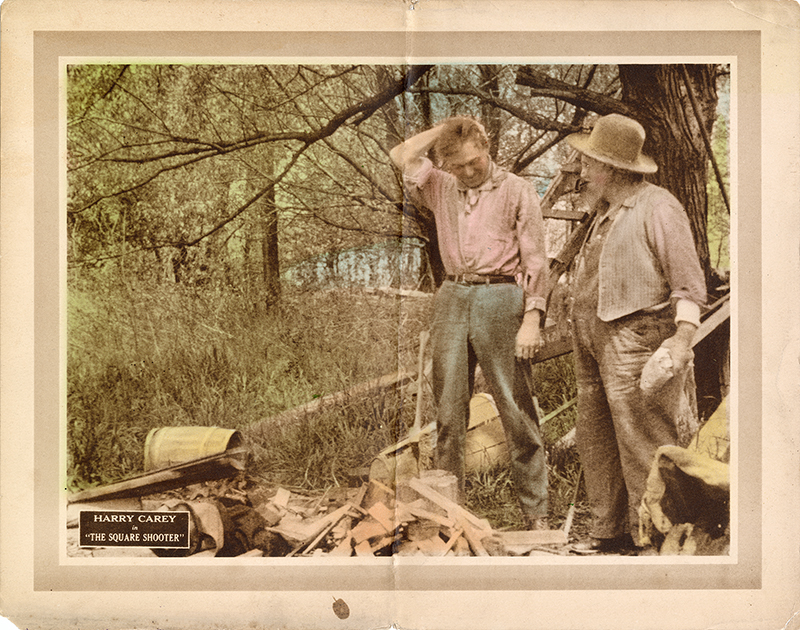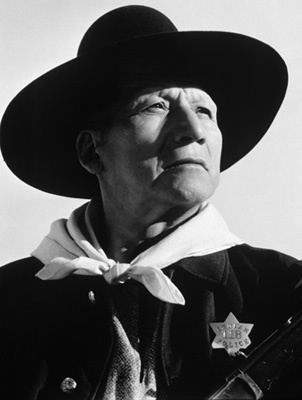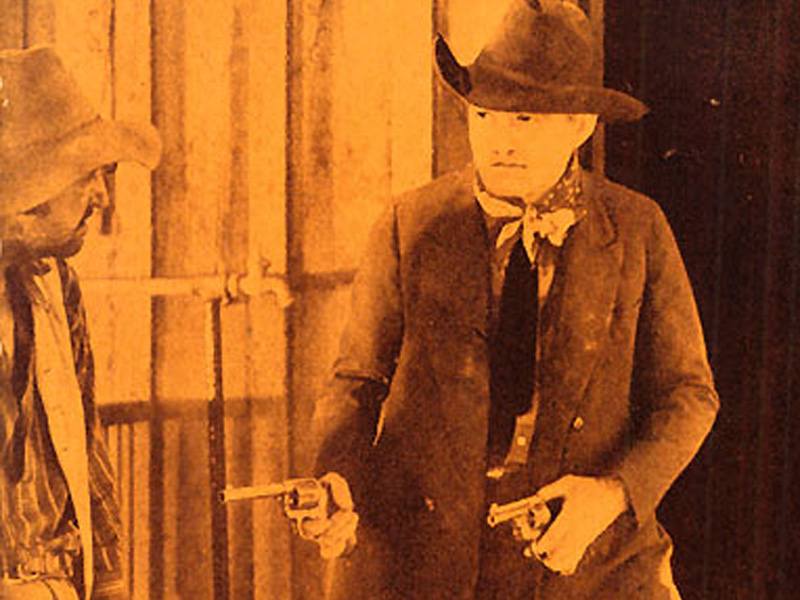|
|


Click image to enlarge
| Download archival scan
John Ford again directs Saugus rancher Harry Carey as the recurring character Cheyenne Harry in "The Square Shooter: A Fight for Love," a 6-reel (60-minute) Canadian Western — filmed in and around Big Bear, Calif. — featuring Native American and Canadian First Nations actors in native roles. (Universal Pictures, 1919.) The film no longer exists, but some rare advertising materials still do. According to a John Ford biography, Carey portrays an outlaw who flees to Canada and fights the villain, a whiskey runner played by Joe Harris, over a First Nations girl and the white love interest (Neva Gerber). The Harris character abducts the white girl and kills a First Nations boy. Carey chases the villain, who falls off a cliff and confesses to the Mounties just before he dies, leaving Carey and the white girl to marry. ("John Ford: A Bio-Bibliography" by Bill Levy. Westport, Conn.: Greenwood Press, 1998.) Newspapers described the setting as the Canadian "rough country" north of Montana. Some noted the remarkable cinematography (by John W. Brown and Ben F. Reynolds), while others said it wasn't a Western because Carey wore a dress suit in the picture instead of "cowboy clothes." All professed to like it — even though some writers clearly hadn't seen it. Cast in the roles of First Nations leaders were Chief John Big Tree (1877-1967) of the Seneca Nation in New York, and Dark Cloud (1861-1918), chief of the Algonquins in Quebec.
Chief John Big Tree was one of three men to pose for James Earle Fraser's Indian Head ("buffalo") nickel, and he was the model for Fraser's famous "End of the Trail" sculpture (source: Oklahoma Historical Society; see bibliography.). In 1949, Chief John Big Tree appeared in the John Wayne vehicle, "She Wore a Yellow Ribbon," which also featured Carey's son, Harry Carey Jr. Dark Cloud graduated from Carlisle Indian School and often modeled for the artist Frederic Remington. Dark Cloud was one of only three cast members in 1915's "The Birth of a Nation" who was alive during the American Civil War. He died in Los Angeles, a victim of the 1918 influenza pandemic (Spanish flu). So, filming of our movie must have been at least partially completed in 1918. Written by Eugene B. Lewis, "The Square Shooter: A Fight for Love" had a working title of "Hell's Neck" which was never used publicly. From newspapers, we see the picture bore the name "The Square Shooter" with the subtitle, "A Fight for Love," when it was originally released March 24, 1919. It also tended to use both the title and subtitle when it made second runs in the late summer-early fall of 1920 and again in 1921 — although when only one name was used, it was "The Square Shooter." The 11x14-inch lobby card shown here would have been used to advertise a second run. If it were a 1919 lobby card, it would be monochrome, usually sepia on buff-colored stock. This type of partial colorization (not all of the image is colorized), with splotchy pastels done in watercolor, began about 1921. Which is to say, it's one of the earliest color-lithographed lobby cards. To the extent this motion picture is remembered at all, it is not known today as "The Square Shooter." It is "A Fight for Love." When the name change occurred, we don't know. It's possible the former name was dropped because Fox released a 5-reel Western called "Square Shooter" starring Buck Jones in August 1920. Some theaters even advertised both pictures with the same title on the same bill.
LW3571: 9600 dpi jpeg from original lobby card purchased by Leon Worden.
|
FULL MOVIE:
Broken Ways 1913
FULL MOVIE 1938
Fan Reply Card <1928
Marriages
Marked Men 1919
A Fight for Love 1919
Harry & Olive 1919
Overland Red 1920
Canyon of the Fools 1923
The Seventh Bandit 1926 (Mult.)
Satan Town 1926
Burning Bridges 1928
Trader Horn 1931
The Vanishing Legion 1931 (Mult.)
The Devil Horse 1932
Rustler's Paradise 1935
Last of the Clintons 1935
Port of Missing Girls 1938
With U.S. VP John Garner 1940
The Shepherd of the Hills 1941 (Mult.)
Hollywood Walk of Fame
Nat Levine 1988
|
The site owner makes no assertions as to ownership of any original copyrights to digitized images. However, these images are intended for Personal or Research use only. Any other kind of use, including but not limited to commercial or scholarly publication in any medium or format, public exhibition, or use online or in a web site, may be subject to additional restrictions including but not limited to the copyrights held by parties other than the site owner. USERS ARE SOLELY RESPONSIBLE for determining the existence of such rights and for obtaining any permissions and/or paying associated fees necessary for the proposed use.
























